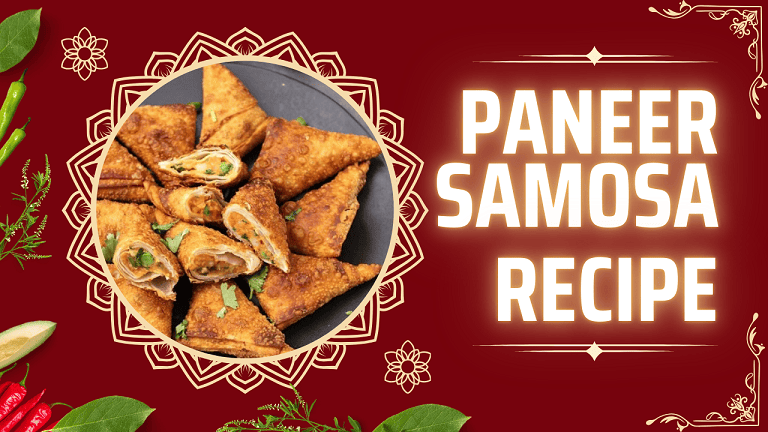Paneer Samosa Recipe
Samosas are a quintessential Indian snack, beloved for their crispy texture and flavorful fillings. Traditionally filled with spiced potatoes or lentils, they can be easily adapted to suit various tastes and dietary preferences.
In this recipe, we will create Paneer Samosas—an exquisite variation that highlights the rich, creamy goodness of paneer, an Indian cottage cheese that is not only delicious but also a great source of protein.
The combination of paneer with aromatic spices and fresh vegetables makes these samosas a delightful treat for any occasion, whether it’s a family gathering, a festive celebration, or a cozy evening snack. This dish reflects India’s diverse culinary culture, where vegetarian options are both creative and satisfying.
Health Benefits of Paneer Samosas
Rich in Protein: Paneer is an excellent source of protein, making these samosas a nutritious option for vegetarians and those seeking to increase their protein intake.
Calcium-Rich: Paneer is also high in calcium, which is essential for healthy bones and teeth.
Vegetable Goodness: Incorporating vegetables like peas and potatoes into the filling adds fiber, vitamins, and minerals, enhancing the nutritional profile of the dish.
Versatile and Customizable: You can easily adjust the recipe to accommodate dietary preferences, such as making it gluten-free or vegan.
Ingredients
For the Dough:
- 2 cups all-purpose flour (maida)
- 1/4 cup oil (vegetable or ghee)
- 1/2 teaspoon salt
- Water, as needed (approximately 1/2 cup)
For the Filling:
- 1 cup paneer, grated or crumbled
- 1/2 cup boiled and mashed potatoes
- 1/2 cup green peas (fresh or frozen)
- 1 medium onion, finely chopped
- 2 green chilies, finely chopped (adjust to taste)
- 1 tablespoon ginger-garlic paste
- 1/2 teaspoon cumin seeds
- 1 teaspoon garam masala
- 1/2 teaspoon red chili powder (adjust to taste)
- 1/2 teaspoon turmeric powder
- 1 tablespoon fresh coriander leaves, chopped
- Salt to taste
- 1 tablespoon lemon juice (optional)
For Frying:
- Oil, for deep frying
Step-by-Step Instructions
Prepare the Dough
Mix the Ingredients: In a large mixing bowl, combine the all-purpose flour and salt. Add the oil and rub it into the flour until it resembles coarse crumbs.
Knead the Dough: Gradually add water to the flour mixture, kneading until you form a smooth and pliable dough. The dough should not be too soft or too stiff.
Cover it with a damp cloth and let it rest for at least 30 minutes. This resting time allows the gluten to develop, making it easier to roll out.
Make the Filling
Cook the Peas: If using fresh peas, steam or boil them until tender. If using frozen peas, simply thaw them.
Sauté the Onions: In a pan, heat a tablespoon of oil over medium heat. Add the cumin seeds and let them sizzle. Then, add the chopped onions and green chilies. Sauté until the onions turn translucent.
Add Spices and Vegetables: Stir in the ginger-garlic paste and cook for a minute until fragrant. Add the boiled and mashed potatoes, green peas, turmeric powder, red chili powder, garam masala, and salt. Mix everything well, ensuring the spices coat the vegetables evenly.
Add Paneer: Remove the pan from the heat and gently fold in the grated paneer and chopped coriander leaves. If desired, add lemon juice for a zesty flavor. Allow the filling to cool.
Shape the Samosas
Roll Out the Dough: Divide the rested dough into equal-sized balls (about the size of a golf ball). On a floured surface, roll each ball into a thin oval or circle, approximately 6-7 inches in diameter.
Cut the Dough: Cut the rolled-out dough in half to form two semi-circles.
Form the Cone: Take one semi-circle and fold it into a cone shape, sealing the edge with a little water. Ensure the tip of the cone is sealed tightly.
Fill the Cone: Fill the cone with about 1-2 tablespoons of the paneer filling, leaving some space at the top.
Seal the Samosa: Moisten the edges with water and pinch to seal the top securely. Make sure there are no gaps. Repeat this process for the remaining dough and filling.
Fry the Samosas
Heat Oil: In a deep frying pan, heat enough oil for deep frying over medium heat. To check if the oil is ready, drop a small piece of dough into the oil; it should sizzle and rise to the surface.
Fry the Samosas: Carefully place the prepared samosas into the hot oil, a few at a time. Fry them until they are golden brown and crispy, turning occasionally for even cooking, which should take about 4-5 minutes.
Drain Excess Oil: Once cooked, remove the samosas from the oil and place them on paper towels to absorb any excess oil.
Tips for Preparing and Cooking
Maximizing Flavor: To enhance the flavor of the filling, sauté the onions until they are golden brown for a richer taste.
Fresh Ingredients: Use fresh, seasonal vegetables for the filling to maximize nutrition and flavor. Farmers’ markets and local vendors often provide the best options.
Texture: To add texture, consider mixing in finely chopped carrots or bell peppers into the filling.
Variations and Substitutions
Gluten-Free Option: Substitute all-purpose flour with a gluten-free flour blend. You may need to adjust the water to achieve the right consistency.
Vegan Option: Replace paneer with tofu or mashed avocado for a dairy-free alternative. Use vegan butter or oil in the dough.
Spicy Variation: For those who enjoy spice, add more green chilies or a dash of hot sauce to the filling.
Cheesy Variations: Try adding different types of cheese like cheddar or mozzarella for an extra cheesy flavor. You can also sprinkle some grated cheese on top of the filling for a gooey texture.
Serving Suggestions
Dipping Sauces: Serve the Paneer Samosas with a variety of dipping sauces, such as mint chutney, tamarind sauce, or a yogurt dip. These complements add contrasting flavors that enhance the experience.
Accompaniments: Pair your samosas with a side of salad or pickles to balance the rich flavors of the dish.
Presentation Tips
Serving Platter: Arrange the samosas on a vibrant serving platter, accompanied by colorful sauces in small bowls. This visually appealing presentation will entice your guests.
Garnishing: Add a sprinkle of fresh coriander leaves or sesame seeds on top of the samosas for an extra pop of color.
Family Style: Serve the samosas in a large bowl or basket, allowing everyone to help themselves. This communal style of serving adds to the joy of sharing food with loved ones.
Cultural Significance
Samosas have a rich history in Indian cuisine and are enjoyed across various regions. Originally brought to India by traders and travelers, samosas have evolved over time, with each region adding its unique twist to the recipe.
From spicy potato fillings in North India to sweeter versions in the South, samosas are a beloved snack that transcends cultural boundaries.
In many Indian households, samosas are a staple during festivals and special occasions. They are often served at tea time or as appetizers during gatherings, making them a cherished part of Indian hospitality.
The preparation of samosas can also be a family affair, where loved ones gather in the kitchen, sharing stories and laughter while creating these delicious treats together.
Conclusion
The Paneer Samosa is a delightful and nutritious snack that perfectly combines the crispy exterior with the rich, flavorful filling of paneer and spices.
By using fresh, locally sourced ingredients readily available in India, you not only enhance the taste but also ensure that you’re serving a wholesome dish that everyone can enjoy.
This recipe allows for creativity, so feel free to customize it to suit your taste preferences. Whether you’re making these samosas for a family gathering, a festive occasion, or just a casual evening snack, they are sure to impress.
So, roll up your sleeves, gather your ingredients, and indulge in the incredible flavors of Paneer Samosas. Happy cooking!
Thanks for visiting Veg Recipe

